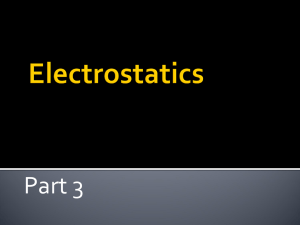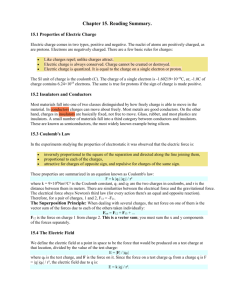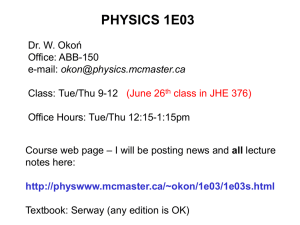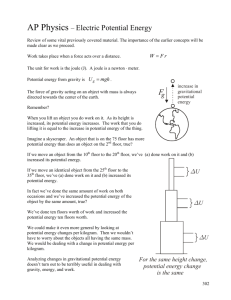Electric Potential Energy
advertisement
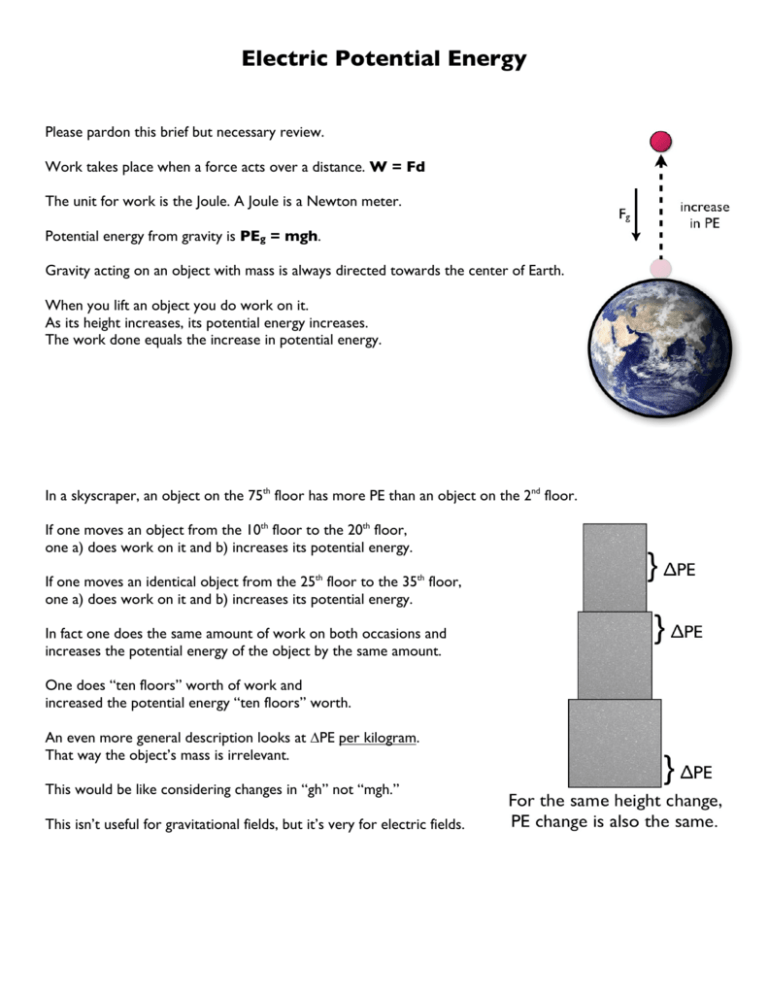
Electric Potential Energy Please pardon this brief but necessary review. Work takes place when a force acts over a distance. W = Fd The unit for work is the Joule. A Joule is a Newton meter. Potential energy from gravity is PEg = mgh. Gravity acting on an object with mass is always directed towards the center of Earth. When you lift an object you do work on it. As its height increases, its potential energy increases. The work done equals the increase in potential energy. In a skyscraper, an object on the 75th floor has more PE than an object on the 2nd floor. If one moves an object from the 10th floor to the 20th floor, one a) does work on it and b) increases its potential energy. If one moves an identical object from the 25th floor to the 35th floor, one a) does work on it and b) increases its potential energy. In fact one does the same amount of work on both occasions and increases the potential energy of the object by the same amount. One does “ten floors” worth of work and increased the potential energy “ten floors” worth. An even more general description looks at ∆PE per kilogram. That way the object’s mass is irrelevant. This would be like considering changes in “gh” not “mgh.” This isn’t useful for gravitational fields, but it’s very for electric fields. Moving charged objects in an electric field also involves doing work and changing potential energy. Electric Potential Energy We know that potential energy is force times distance: PE = F d We know the force between two charges: F = k q1 q2 / d2 Plug Coulomb’s law into the PE equation: PE = (k q1 q2 / d2) d Or, simply: PEe = k q1 q2 / d Exercise: An electron in hydrogen is 5.3•10-11 m from the proton. Calculate its potential energy relative to the proton. qe = -1.6•10-19C qp = 1.6•10-19C PEe = k q1 q2 / d PEe = 9•109Nm2 / C2 (-1.6•10-19C • 1.6•10-19C) / 5.3•10-11m PE = 4.35•10-18J Work in the Electric Field Work is done when a particle is moved in an electric field and the PE changes. Unlike charges: Pull charges apart – PE increases Push charges together – PE decreases Like charges: Pull apart – PE decreases Push together – PE increases The work done in moving the charge is equal to the potential energy difference between the two points. W=Fd F = qE W = qEd W = work done in Joules q is the test charge (not the charge making the field) E is the electric field strength d is the displacement of the charge We know that the magnitude of the work done equals the magnitude of the PE change. However, to account for repulsion between similar charges, the sign flips. ∆PE = -W ∆PE = -qEd Potential Difference: To make things even more general, consider the change in potential energy per Coulomb of charge. This is called the potential difference. V = ∆PE / q V = potential difference, electric potential, or voltage ∆PE = change in potential energy per charge Potential Difference: the change in potential energy as a charge is moved from one point to another, divided by the amount of charge. Potential difference is a scalar quantity. PE = -qEd V = -Ed This equation is commonly rearranged. E = -V / d Note that the electric field can be expressed in units of V/m as well as N/C. Also note that PE = qV A potential difference of one volt means that it takes one joule of energy to move a one Coulomb charge in the field. A potential difference of 1000 V means that it takes 1000 J to move 1 C of charge in the field. Potential difference is a very important concept in electricity, so take special care to master this. You must have a solid understanding about potential difference and how it works. Charge moves because of the potential difference, ΔV. The bigger the potential difference between two points, the more the charge will want to move. Electric potential is a scalar quantity. Exercise: The voltage between two points is 12.0 V. How much work will move 2µC between the points? W = qV W = 2•10-6C • 12V W = 2.4•10-5J Exercise: Two charged plates are 5cm apart. The electric field between them is 775 N/C. Calculate the potential difference between the plates. Calculate the work done moving an electron from one plate to another? V = -Ed V = -(775 N/C) (0.05m) V = -38.8V W = qV W = -1.6•10-19C (-38.8V) W = 6.21•10-18J Exercise: The voltage between two parallel plates is -120.0V. The plates are 2.5cm apart. Calculate the electric field between them. E = -V / d E = 120V / 0.025m E = 4800 V/m Exercise: A proton is released from rest in an electric field of 80,000V/m. It moves 0.5m. Calculate the voltage. Calculate the change in potential energy. Calculate the final velocity. V = -Ed V = -80,000V/m • 0.5m = -40,000V PE = qV PE = 1.6•10-16C (-40,000V) PE = -6.4•10-15J KE = PE ½ m v2 = PE v = √(2 PE / m) v = √(2 (6.4•10-15J) / (1.67•10-27kg)) v = 2.8•106m/s Potential Difference and Conductors In a conductor, the valence electrons essentially are free to move. It takes no work to move them. This means that there is no potential difference within a conductor from one point to another. If one end of a wire has a potential of 12 V, the other end will also have a potential of 12 V. All points in a conductor are equipotential. When conductors are joined together, the charge evenly distributes throughout the newly formed conductive system. The new conductor system will also be equipotential.





